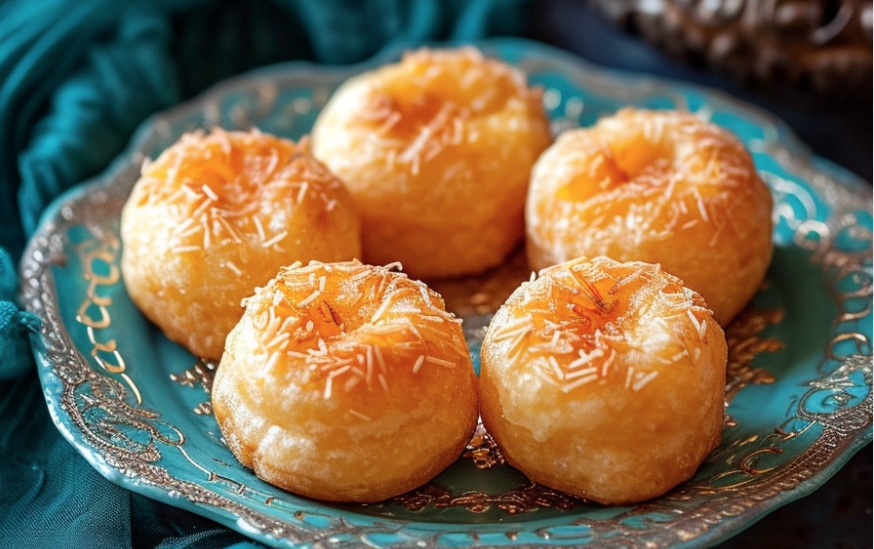Balushahi is a delicious sweet treat that originates from the Indian subcontinent. It’s made from flour, sugar, and ghee (clarified butter), and is deep-fried to golden perfection. But if you’re watching your calorie intake, it’s essential to know that balushahi is quite calorie-dense. On average, one piece of balushahi can contain around 250-300 calories. This can vary slightly depending on the size and ingredients used in its preparation. Therefore, it’s crucial to enjoy balushahi in moderation, especially if you’re keeping track of your daily calorie intake.
In today’s world, we’re all getting more mindful about what we eat, and that includes even our favorite sweet treats. So, while we celebrate the taste and tradition of balushahi, let’s also take a peek at the numbers behind this beloved sweet. Don’t worry, though! This isn’t about saying goodbye to our beloved treat. It’s more about enjoying it with a little understanding and maybe even finding some creative ways to indulge mindfully.
So, whether you’re a balushahi newbie or a seasoned sweet tooth, join us on this exploration! We’ll uncover the secrets of these golden delights, from their fascinating history to their nutritional value. We’ll even share some pro tips on enjoying them in a mindful way, ensuring your treat remains just that – a delightful treat, not a calorie culprit.
What is Balushahi?

Balushahi is a traditional sweet delicacy originating from the Indian subcontinent. Some say the name comes from “Baloo Shah,” a famous chef, while others believe it means “king of sweets” – both fitting titles for this sweet delight!. It is made by deep-frying a dough consisting of flour, sugar, and ghee (clarified butter) until it achieves a golden brown color. Once fried, the balushahi is typically dipped in a sugar syrup flavored with cardamom or saffron, giving it a distinctive taste. Balushahi has a flaky texture with a slightly crispy exterior and a soft, melt-in-your-mouth interior. It is often enjoyed during festive occasions, celebrations, or as a special treat.
Read Also – Ginger Black Tea Benefits
The Origins of Balushahi
Balushahi has a long and sweet history, dating back centuries! Some say it originated in Mughal kitchens, while others trace it to even earlier times. What we know for sure is that it has traveled through different regions, changing flavors and shapes along the way. In the south, it’s called “badusha,” while in Rajasthan, it’s known as “makhan vada.” No matter the name, it’s a taste of tradition!
What are the Benefits of Balushahi?
While balushahi is delicious, remember, everything is best in moderation. While it may have some energy from carbs and a bit of protein, it’s also high in sugar and fat. If you’re looking for a healthier option, try homemade versions with less sugar or explore other Indian sweets like dates or nuts. Remember, mindful indulgence is key!
How to Make Balushahi?
Ready to unleash your inner chef and whip up some balushahi magic? Don’t worry, it’s easier than it sounds! Here’s a simplified guide to making these bite-sized delights:
Ingredients:
- 1 cup all-purpose flour (maida)
- 1/4 cup ghee, melted
- 1/4 cup yogurt
- 1/4 teaspoon baking powder
- 1/4 teaspoon baking soda
- Pinch of salt
- Oil for frying
- 1 cup sugar
- 1/2 cup water
- 1/4 teaspoon cardamom powder
- Few saffron strands (optional)
Instructions:
- Mix it Up: In a large bowl, combine flour, baking powder, baking soda, and salt.
- Creamy Dream: In another bowl, whisk together melted ghee and yogurt until light and fluffy.
- Dough Time: Gradually add the ghee mixture to the dry ingredients, mixing until a soft dough forms. Don’t overmix!
- Rest & Rise: Cover the dough and let it rest for 30 minutes.
- Shape Up: Pinch off small pieces of dough and roll them into smooth balls. Gently press your thumb in the center to make a small indentation.
- Heat it Up: Heat oil in a deep pan over medium heat. You want it hot but not smoking.
- Golden Dip: Fry the balushahi in batches until golden brown. Don’t overcrowd the pan!
- Sugar Rush: While the balushahi fry, make sugar syrup by boiling sugar and water until it thickens slightly. Add cardamom powder and saffron (if using).
- Sweet Soak: Once golden, remove the balushahi from the oil and drain on paper towels. Then, immediately dunk them in the warm sugar syrup for a few seconds.
- Cool & Enjoy: Let the balushahi cool on a wire rack and then dive into deliciousness!
Tips & Tricks:
- For a healthier twist, substitute half the all-purpose flour with whole wheat flour.
- Use a slotted spoon to remove the balushahi from the oil and prevent them from absorbing too much fat.
- Don’t skip the resting time! It helps the dough become softer and fluffier.
- Adjust the sugar syrup sweetness to your preference.
- Store leftover balushahi in an airtight container at room temperature for up to 2 days.
Calories in Balushahi:
One balushahi packs around 70-80 calories, depending on size and recipe. That’s not too bad, but remember, portion size matters! Here’s a table to show you how the calories can vary depending on the size of the balushahi:
| Serving Size | Calories |
|---|---|
| 1 balushahi (30g) | 152 calories |
| 2 balushahi (60g) | 304 calories |
| 3 balushahi (90g) | 456 calories |
As you can see, the calorie count adds up quickly as you eat more balushahi. It’s important to be mindful of your portion size, especially if you’re watching your weight.
Here are some other factors that can affect the calorie content of balushahi:
- Recipe: Some recipes use more ghee or sugar than others, which can increase the calorie count.
- Toppings: If you add toppings like nuts or dried fruit, you’ll be adding more calories.
- Size: As mentioned above, larger balushahi will have more calories than smaller ones.
Tips for Enjoying Balushahi in Moderation:
- Share with friends and family: This way, you can enjoy the treat without consuming too many calories yourself
- Make your own balushahi: This way, you can control the ingredients and adjust the recipe to make it healthier.
- Pair balushahi with a healthy snack: This will help you feel more satisfied and prevent you from overeating.
- Be mindful of your portion size: Pay attention to how much you’re eating and stop when you’re feeling satisfied.
Nutritional Breakdown of Balushahi: Sweet Treat, Balanced Bite?
While balushahi might be a delightful indulgence, knowing its nutritional content can help you enjoy it mindfully. Here’s a table summarizing the average values per one medium-sized balushahi (around 30g):
| Nutrient | Amount | % Daily Value (DV)** |
|---|---|---|
| Calories | 70-80 | 3-4% |
| Fat | 4-5g | 6-8% |
| Saturated Fat | 2-3g | 10-15% |
| Cholesterol | 5mg | 2% |
| Sodium | 20mg | 1% |
| Carbohydrates | 10-12g | 3-4% |
| Sugars | 8-10g | 8-11% |
| Protein | 1-2g | 2-4% |
| Fiber | 0.5g | 2% |
DV percentages based on a 2,000 calorie diet.
Remember:
- These are average values, and the actual content can vary depending on recipe, size, and ingredients.
- Balushahi is generally high in sugar and fat, contributing to higher calorie count.
- It has minimal protein and fiber.
- Enjoy balushahi in moderation as part of a balanced diet.
Additional Points:
- Consider homemade versions with healthier alternatives like whole wheat flour or less sugar.
- Pair balushahi with fruits or nuts for additional nutrients and fiber.
- Be mindful of portion size and enjoy responsibly!
I hope this table helps you understand the nutritional profile of balushahi and make informed choices about enjoying this sweet treat!
Comparison with other Indian Sweets (per 30g serving):
| Sweet | Calories | Fat | Carbs |
|---|---|---|---|
| Gulab Jamun | 130 | 5g | 20g |
| Jalebi | 100 | 3g | 25g |
| Rasgulla | 80 | 2g | 18g |
| Mysore Pak | 150 | 8g | 22g |
Read Also – Benefits of Papaya Soap
Faqs Related to Calories in Balushahi
How many calories are in one serving of Balushahi?
The calorie content of Balushahi can vary depending on its size and ingredients. On average, a single piece of Balushahi may contain around 150-200 calories.
Are Balushahi high in calories?
Yes, Balushahi are considered a high-calorie sweet treat due to their ingredients such as refined flour, sugar, and ghee (clarified butter).
What factors influence the calorie content of Balushahi?
The calorie content of Balushahi depends on factors such as the size of the pastry, the amount of sugar used in the syrup, and the type and quantity of ghee used in frying.
How can I estimate the calorie content of homemade Balushahi?
You can estimate the calorie content of homemade Balushahi by calculating the total calories from each ingredient used in the recipe and dividing by the number of servings.
Are there any ways to reduce the calorie content of Balushahi?
To reduce the calorie content of Balushahi, you can use healthier alternatives such as whole wheat flour instead of refined flour, natural sweeteners like honey or stevia instead of sugar, and cooking methods such as baking instead of deep-frying.
Can Balushahi be included in a balanced diet?
While Balushahi are high in calories and should be consumed in moderation, they can be enjoyed occasionally as part of a balanced diet when paired with nutritious foods and consumed in appropriate portion sizes.
Are there any health benefits to eating Balushahi?
Balushahi are primarily a source of empty calories and are not particularly nutritious. However, they can provide a quick source of energy and may contribute to enjoyment and satisfaction when consumed as an occasional treat.
Should I be concerned about the calorie content of Balushahi?
If you are trying to manage your weight or monitor your calorie intake, it’s important to be mindful of the calorie content of Balushahi and other high-calorie foods. Enjoy them in moderation and balance them with healthier options.







